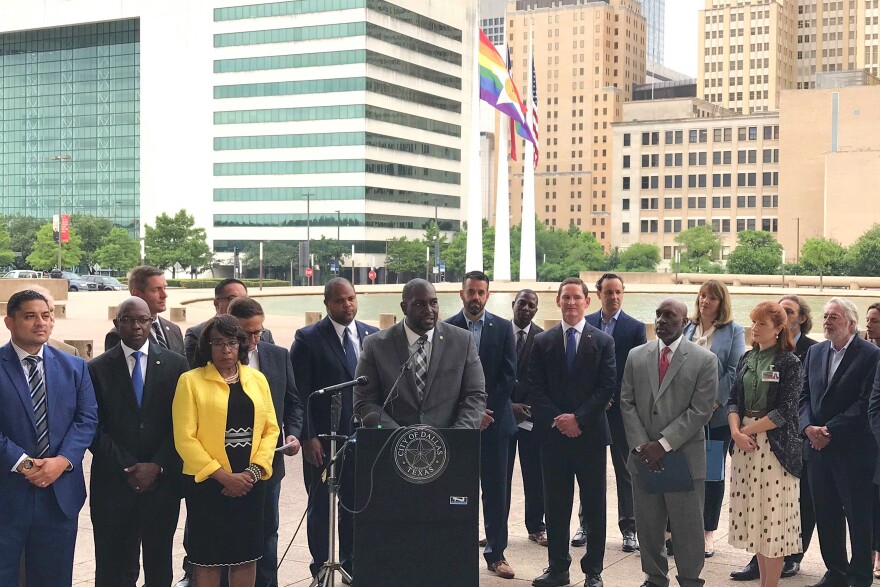The ambitious effort to house thousands of individuals and families will combine the resources of three cities — Dallas, Grand Prairie and Mesquite — as well as the county, the local housing authority, and the Metro Dallas Homeless Alliance. It’ll rely on the efforts of many more public agencies, philanthropies and nonprofits to achieve its goals.
“We’ll be able to take thousands of people off of our streets, put them into safe housing, and give them the tools and resources they need to be successful,” said Dallas Mayor Eric Johnson, flanked by more than two dozen city officials, nonprofit executives and civic leaders at a news conference outside of Dallas City Hall.
Despite a mundane bureaucratic name — Dallas Real Time Rapid Rehousing — the plan has the potential to fundamentally improve the lives of thousands of individuals and families and cut the region's homeless population by more than half.
“We have to provide all people in our city with viable pathways to better lives. For those who are experiencing homelessness, that means we have to address their most basic needs first,” Johnson said.
Breaking The Cycle
The plan includes an additional 650 permanent housing vouchers that will provide long-term subsidized housing for families, domestic violence survivors, and people with severe mental and physical health challenges.
About half the people who attain housing with the permanent vouchers are expected to be under the age of 18, according to Jorge Baldor, who leads DHA Housing Solutions for North Texas. He said children who experience homelessness often face homelessness as adults.
“We know that that’s the only way to change their trajectory and make sure that this is a cycle that is broken,” said Baldor.
Another 2,000 people will be given a place to live in for up to a year while they receive health care, social services, and job training. It’s a model called rapid rehousing, which aims to stop people from cycling in and out of homelessness by giving them help to address the underlying issues that prevent them from maintaining housing.
“Once people get stabilized, they tend to stay out of homelessness,” said Dallas County Judge Clay Jenkins. “So we’re very excited about the potential of this program.”
The effort will be paid for mostly with federal dollars, but it will also rely on $10 million in private donations to pay for routine items people need after experiencing homelessness, such as furniture and toiletries. Federal funding does not cover these basic essentials.
‘A Once In A Generation Opportunity’
The pandemic produced a sharp increase in need to serve people experiencing homelessness and prevent others from joining their ranks, while making the basic operation of services even more challenging. Homeless shelters had to reduce capacity in order to maintain social distancing, and many volunteer-run, face-to-face efforts had to pivot in the face of a dangerous new virus.

In January 2020, for the first time in years, the region registered a decrease in people experiencing homelessness. But the improvement was slight, and it was fleeting. The next year’s census found nearly 4,000 people in Dallas County living on the streets and in homeless shelters in January, a sharp increase.
While the pandemic piled on challenges, it also offered new opportunities to try bold new approaches, as Congress pumped trillions of federal dollars into local and state governments across the country in an effort to prop up a beleaguered economy.
Federal funds will pay for most of the $70 million initiative announced on Wednesday, in the form of housing vouchers and cash approved in the American Rescue Plan Act, the pandemic relief and stimulus package proposed by the Biden Administration.
While the funding is recent, the collaboration that made Wednesday’s announcement goes back years, according to Dallas County Commissioner Theresa Daniel, who called the effort a “once in a generation opportunity to truly put a dent in homelessness in our community.”
Laying The Groundwork
In 2018, a city-county Dallas Area Partnership to End and Prevent Homelessness was launched to better coordinate resources and efforts.
“We’re able to stand here now because we’ve been collaborating in the area of housing and homelessness for some time, and we are now shovel-ready,” Daniel said.
Dallas City Council member Casey Thompson, who co-chaired the partnership, said the new housing initiative is also a matter of equity. In March, the council committed to addressing the long history of policies and practices that undermined education, employment, housing, and other opportunities for people of color in Dallas.
“Ending homelessness in the city of Dallas, we will make sure that there is a focus on racial equity, to make sure those who are most impacted are the ones who have the greatest opportunity,” Thomas said.
A Larger Challenge
The funding may offer a once-in-a-generation opportunity, but it won’t address the upstream drivers of homelessness.
The cost of housing in Dallas continues to climb far faster than wages, and a significant number of families and individuals survive on incomes that leave them without any financial cushion to handle unexpected bills such as a hospital visit or a car repair.
Metro Dallas Homeless Alliance Board Chairman Peter Brodsky said the region still needs to come up with policies and procedures that will spark the development of an adequate supply of affordable housing, which will require a significantly larger sum of money.
“Hopefully we’ll use these two years, while we’re housing a lot of people, to put a policy in place that’ll work for the next 20 years,” Brodsky said.
Got a tip? Christopher Connelly is KERA's One Crisis Away Reporter, exploring life on the financial edge. Email Christopher at cconnelly@kera.org.You can follow Christopher on Twitter @hithisischris.
KERA News is made possible through the generosity of our members. If you find this reporting valuable, consider making a tax-deductible gift today. Thank you.


